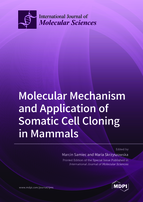Molecular Mechanism and Application of Somatic Cell Cloning in Mammals
A special issue of International Journal of Molecular Sciences (ISSN 1422-0067). This special issue belongs to the section "Molecular Pathology, Diagnostics, and Therapeutics".
Deadline for manuscript submissions: closed (30 September 2022) | Viewed by 31766
Special Issue Editors
Interests: reproductive biology and biotechnology in different mammalian species (especially pigs, goats, cattle, rabbits and horses); assisted reproductive technologies (ARTs)—experimental and applied embryology; intra- and interspecies somatic cell cloning by somatic cell nuclear transfer (SCNT); transgenic research; parthenogenetic activation of oocytes (methods and molecular mechanisms of oocyte activation); in vitro embryo production (IVP)—in vitro oocyte maturation (IVM), in vitro fertilization (IVF), intracytoplasmic sperm injection (ICSI), in vitro embryo culture (IVC); stem cell research; epigenetic and molecular aspects of embryonic development—epigenetics in developmental biology, epigenetic modulation of nuclear donor cells (somatic cells, stem cells), SCNT-derived oocytes or cloned embryos; unravelling the transcriptomic and proteomic profiles in nuclear donor cell lines (somatic and stem cell lines) and nuclear recipient oocytes; the ART-mediated programs focused on biotechnological, transgenic and biomedical research
Special Issues, Collections and Topics in MDPI journals
Interests: animal reproduction biotechnology; somatic cell cloning in different mammalian species; embryonic cell cloning in different mammalian species, including embryo bisection methods; in vitro embryo production; in vitro oocyte maturation and microsurgical in vitro fertilization by ICSI; transgenesis; modern strategies to assess the molecular quality of somatic cell lines and female gametes for the purposes of advanced ARTs
Special Issues, Collections and Topics in MDPI journals
Special Issue Information
Dear Colleagues,
Although approximately 25 mammalian species have been cloned by somatic cell nuclear transfer (SCNT) so far, the efficiency of somatic cell cloning is still at a disappointingly low level ranging from 0.1% to less than 5% as measured by the percentage of the cloned progeny generated to the number of oocytes reconstructed by SCNT. Therefore, the studies focused on somatic cell cloning require an important milestone to improve the pre- and/or post-implantation capabilities and enhance the molecular quality of cloned mammalian embryos. This finding seems to be a sine qua non condition for increasing the effectiveness of SCNT as assisted reproductive technology (ART) and its potential of wide application to embryological, biotechnological, transgenic and biomedical research.
To sum up, this Special Issue offers/opens the possibility of publishing the articles and reviews aimed at exploring or recognizing a variety of molecular and epigenetic determinants of the SCNT efficacy at the levels of nuclear donor cells, nuclear recipient oocytes and nuclear-transferred embryos. Their broad identification can contribute to amelioration, optimization and implementation of the somatic cell cloning. These latter allow this method to become one of the most important, reliable and feasible ART strategies for the purposes of experimental and applied embryology, biotechnology, ex situ biodiversity preservation, transgenics, biomedicine, biopharmacy and creation of animal models for etiopathogenesis and pathophysiology of human diseases.
Prof. Dr. Marcin Samiec
Prof. Dr. Maria Skrzyszowska
Guest Editors
Manuscript Submission Information
Manuscripts should be submitted online at www.mdpi.com by registering and logging in to this website. Once you are registered, click here to go to the submission form. Manuscripts can be submitted until the deadline. All submissions that pass pre-check are peer-reviewed. Accepted papers will be published continuously in the journal (as soon as accepted) and will be listed together on the special issue website. Research articles, review articles as well as short communications are invited. For planned papers, a title and short abstract (about 100 words) can be sent to the Editorial Office for announcement on this website.
Submitted manuscripts should not have been published previously, nor be under consideration for publication elsewhere (except conference proceedings papers). All manuscripts are thoroughly refereed through a single-blind peer-review process. A guide for authors and other relevant information for submission of manuscripts is available on the Instructions for Authors page. International Journal of Molecular Sciences is an international peer-reviewed open access semimonthly journal published by MDPI.
Please visit the Instructions for Authors page before submitting a manuscript. There is an Article Processing Charge (APC) for publication in this open access journal. For details about the APC please see here. Submitted papers should be well formatted and use good English. Authors may use MDPI's English editing service prior to publication or during author revisions.
Keywords
- somatic cell nuclear transfer (SCNT)
- assisted reproductive technology (ART)
- somatic cell cloning







